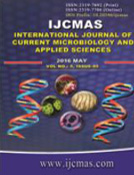


 National Academy of Agricultural Sciences (NAAS)
National Academy of Agricultural Sciences (NAAS)

|
PRINT ISSN : 2319-7692
Online ISSN : 2319-7706 Issues : 12 per year Publisher : Excellent Publishers Email : editorijcmas@gmail.com / submit@ijcmas.com Editor-in-chief: Dr.M.Prakash Index Copernicus ICV 2018: 95.39 NAAS RATING 2020: 5.38 |
Caffeine (1, 3, 7 – trimethylxanthine) is a member of methylxanthines, widely used as biological active substance in the world and known for its various pharmacological effects. This study investigated antimicrobial activity of caffeine and the ability of Subinhibitory Concentration’s (SIC’s) of the same to interfere with the bacterial proteolytic activity, hemolytic activity and biofilm formation. Synergistic activity of caffeine was also studied with currently used therapeutic drugs against MRSA. Antimicrobial activity against four clinical isolates of MRSA namely MRSA1, MRSA2, MRSA3, MRSA 4 along with standard strain Staphylococcus aureus ATCC 6538 by broth dilution method. Caffeine inhibited bacterial growth at 5 mg/mL concentration. Subinhibitory concentrations (SIC’s) thus selected were 1:2, 1:5 and 1:10 dilutions of MIC value i.e. 2.5 mg/ml, 1 mg/ml and 0.5 mg/ml respectively. There was a marked decrease in proteolytic activity in the range of 29% to 40%, hemolytic activity in the range of 9%- 19%) and in biofilm formation 14%- 21% in test organisms at 2.5 mg/ml. Marked synergistic activities were found against Mupirocin, Amoxyclav, Chloramphenicol, Rrifampicin, and Linezolid. Such activity of caffeine could be crucial for topical applications of it. Further characterization of caffeine with respect to its anti-cancer activity, immunomodulatory activity and mode of action need to be carried out to evaluate the biological activities and medicinal utility of caffeine.
 |
 |
 |
 |
 |